We passed a large group of folks standing out in an open area with a ranger—no doubt the morning flower walk--but continued on up a ways until we found a nice turnout near a gravel wash. I got out to clamber around in the wash looking for flowers.
Most of the flowers in the lower valley are Desert Gold (Geraea canescens). There were still lots of them as we went up in elevation.
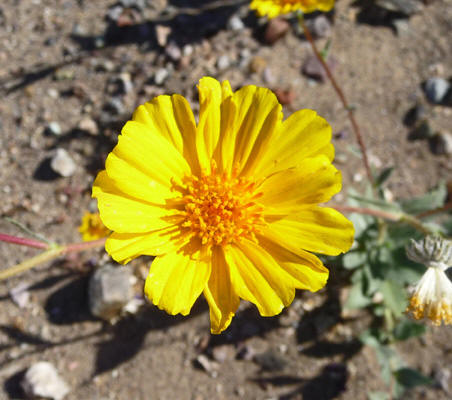
And there was a lot of Catha-leaved Phacelia (Phacelia calthifolia) giving the desert a purple haze.
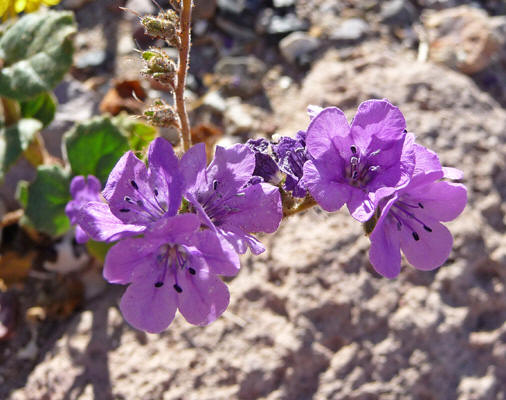
The Gravel Ghost (Atrichoseris platyphylla) waves in the breeze on a very long stem. When there are bunches of them they look like a whole flock of ghosts drifting along over the gravel.
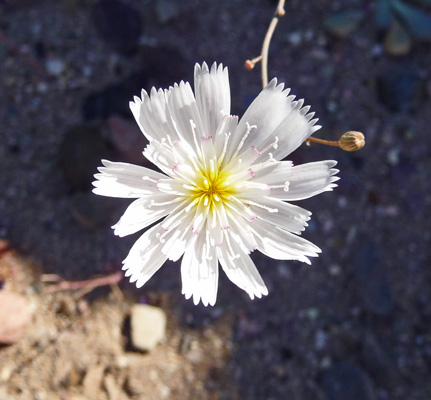
The overall effect at this elevation was still mainly yellow.

The wind earlier in the week had thinned the flowers out some but they were still blooming up a storm as far as I was concerned.
We drove a bit further up and stopped again near another wash. Here the flowers weren’t as dense but there was a bigger variety.

There were Golden Evening Primrose (Camissonia brevipes).
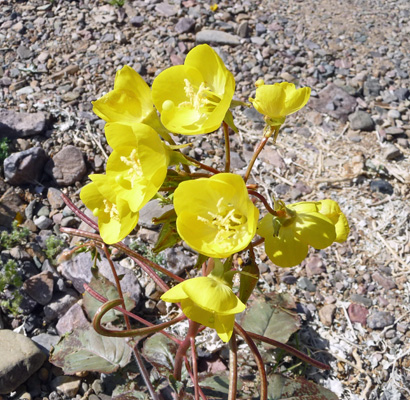
Here and there, I found a few Panamint catseye (Cryptantha angustifolia).
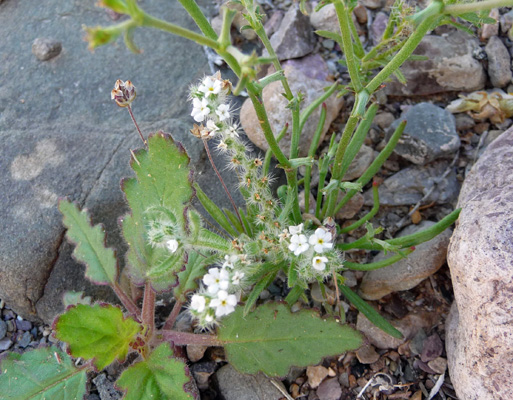
And then I hit the jackpot, I saw a Desert Five-spot (Eremalche rotundifolia) in bud and a little further along there was one that was just starting to open.
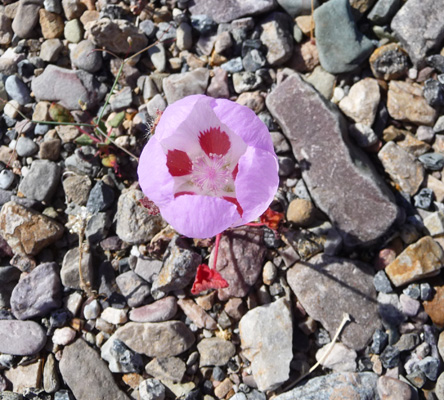
Meanwhile Walter was across the road and found a five-spot in full bloom and I came a-running. Isn’t she just swell?
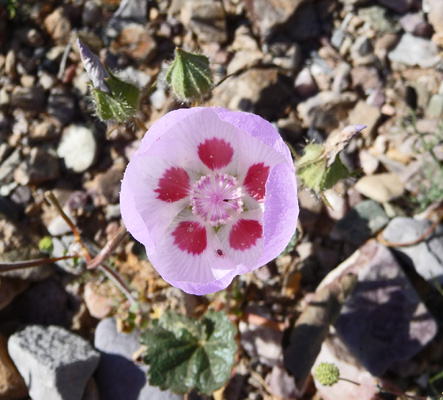
I found some HUGE five-spot plants with buds galore on them too. There will be flowers here for quite a while no matter what the temperatures are. Of course by this point it was in the 70’s because we were further up in elevation.
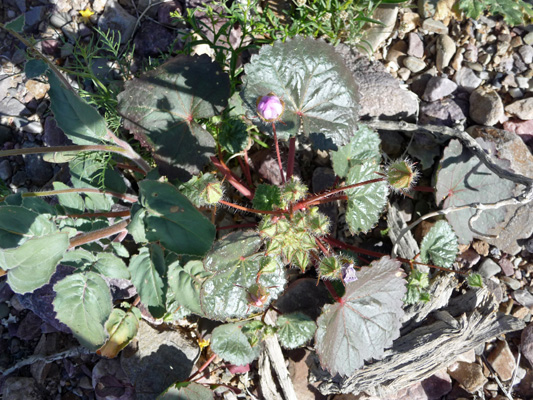
We drove on and stopped once again further up the road in yet another wash where there were still another selection of flowers.
There were Brown-eyed Evening Primrose (Camissonia claiformis)—which remarkably hadn’t faded yet from its bloom the night before. The books say they turn pink in the morning.
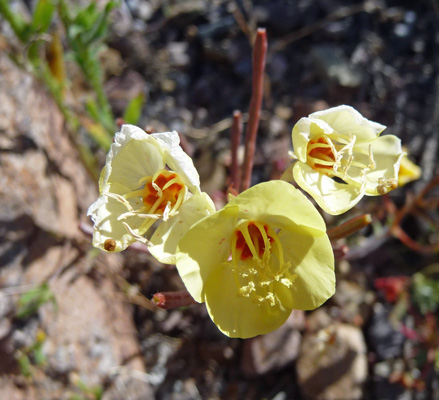
And there was tons of Desert Chicory (Rafinesquia neomexicana) which looks a lot like Gravel Ghost but grows close to the ground and has much bigger oblong buds.
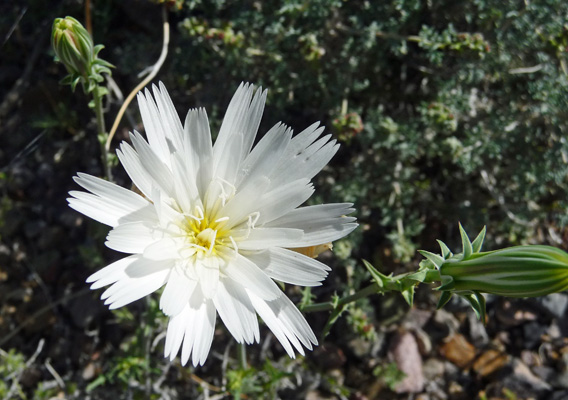
There were little clumps of Mojave Desert Star (Monoptilon belliodes)—little white daisies that are less than a 1/2” across.
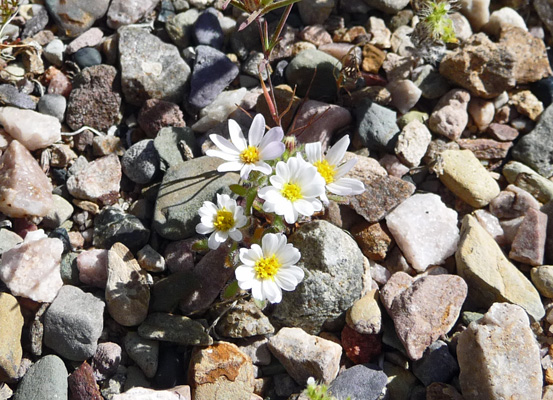
And there were just a few Fremont Phacelia (Phacelia fremontii). I like the yellow in the throats.
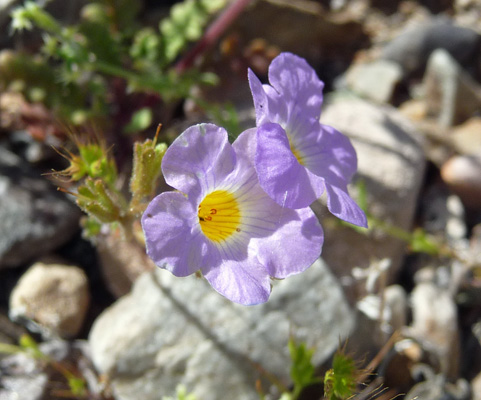
There were one or two Pebble Pincushion (Chaenactis carphoclina).
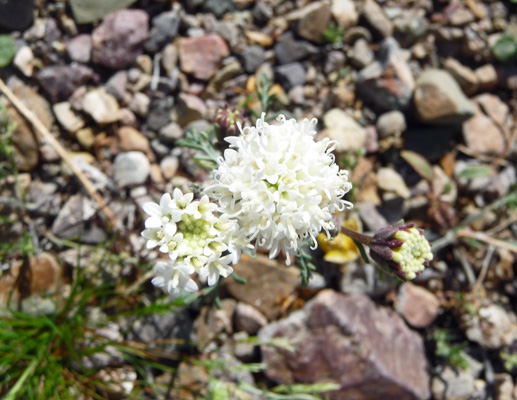
And there were a sprinkling of these nice little yellow flowers whose name I have not been able to ascertain.

Last but not least, I found one example of Checker Fiddleneck (Amsinckia tessellate).
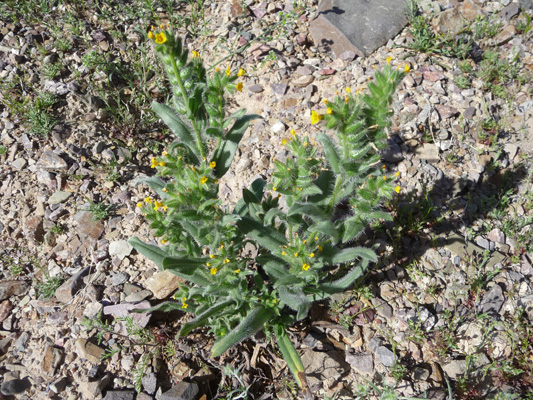
By this point I was very happy. Thirteen different kinds of flowers in a day is a pretty good wildflower day, especially in the desert. I’d just wanted to see some Five-spot so I was more than happy.
We followed Daylight Pass Road out of the park and out to Rhyolite, an old gold mining town, that boomed and busted between 1905 and 1920. At its peak in 1908 there were 8,000 people there. By 1920 the population was estimated at 14.
There were even Desert Gold coating the face of the tailings piles here.
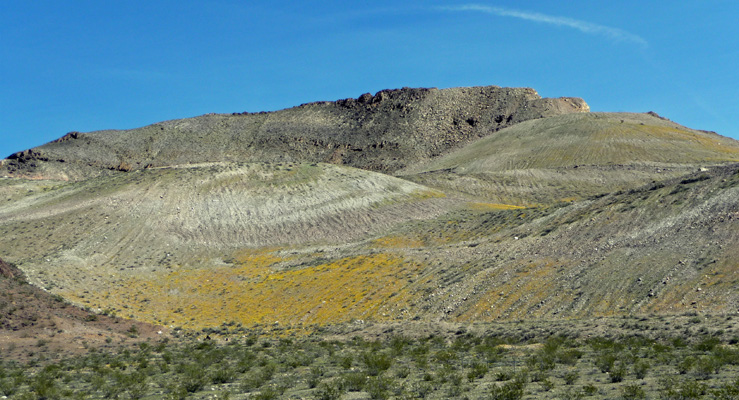
Most of the buildings here were built in 1906 before the San Francisco Earthquake drew funding away from things like mining development. There were three railroads that served Rhyolite. The Las Vegas and Tonopah RR built this depot in 1909 and it’s one of the few buildings that’s mostly intact.
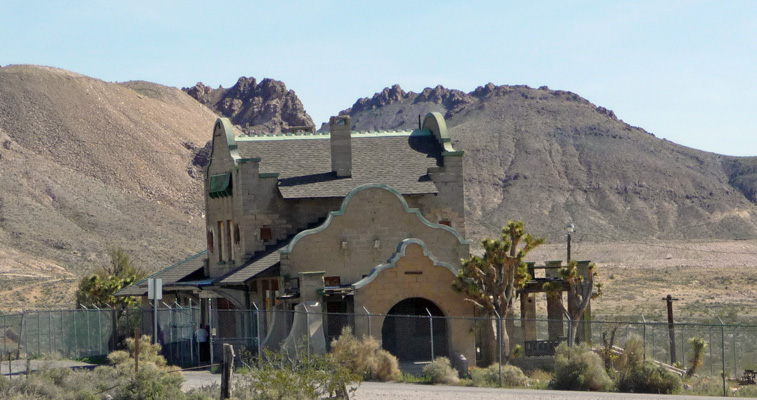
The Cook Bank was built in 1908 and has crumbled away artistically.
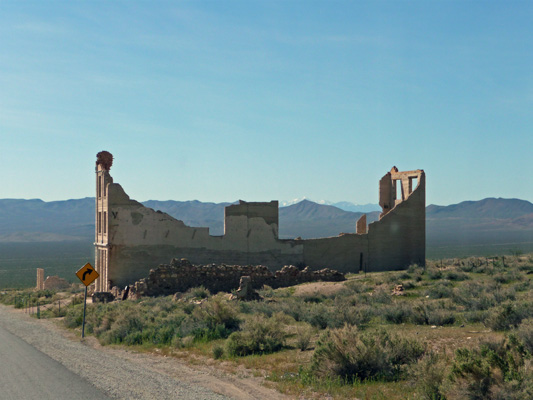
Most of the rest of the buildings in town are just foundations with bits of walls. But Tom Kelly’s Bottle House is holding its own. It was built for a raffle in 1906 and people lived in it for years until it became a curio shop. Now it’s locked up tight.
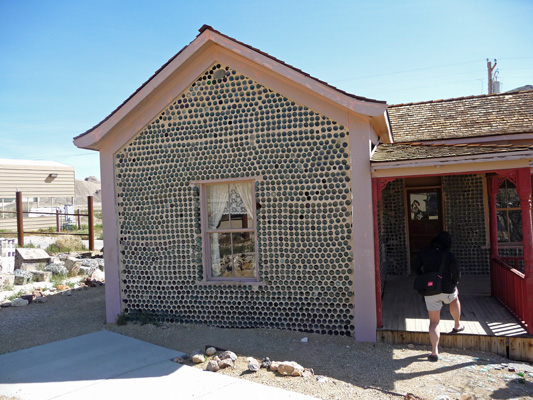
Someone has replaced a lot of the wood trim to help preserve it but the original bottles just keep on holding it all together.
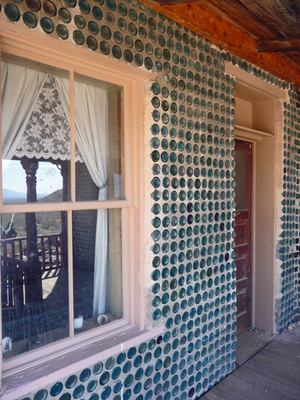
There was a huge old Joshua Tree (Yucca brevifolia) in the yard here .
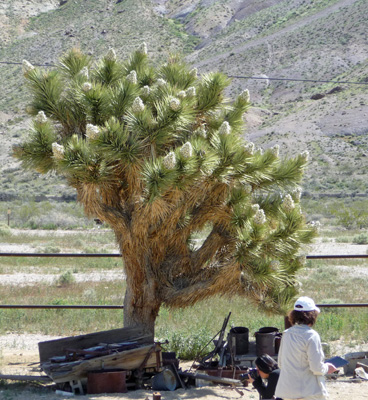
And it was in bloom.
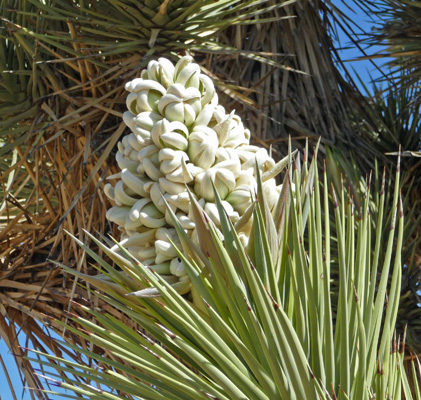
We headed back towards the valley and I spied a large mat of purple flowers, so I stopped and hiked back to discover a nice patch of Fremont Phacelia (Phacelia fremontii).
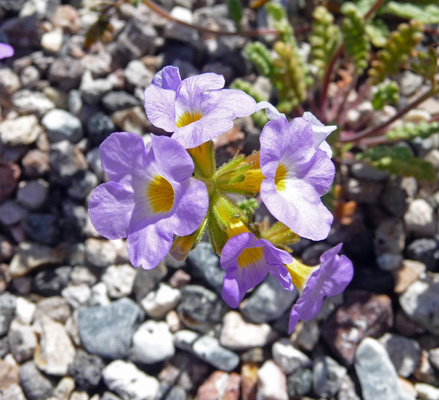
And some Desert Dandelions (Malacothrix glabrata).
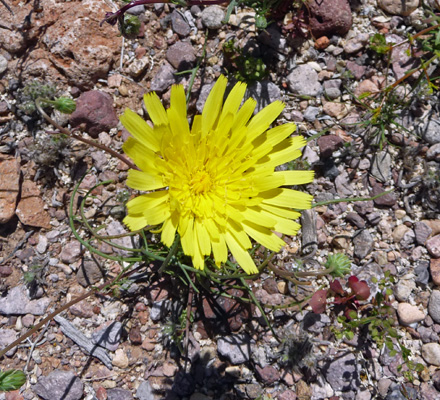
For variety, we took the Mud Canyon Road on the way back instead of retracing our steps along the Beatty Cutoff and I stopped to take a photo of the Mesquite Flat Sand Dunes from the pass.

While I was at it I found a nice patch of Notch-leafed Phacelia (Phacelia crenulata).
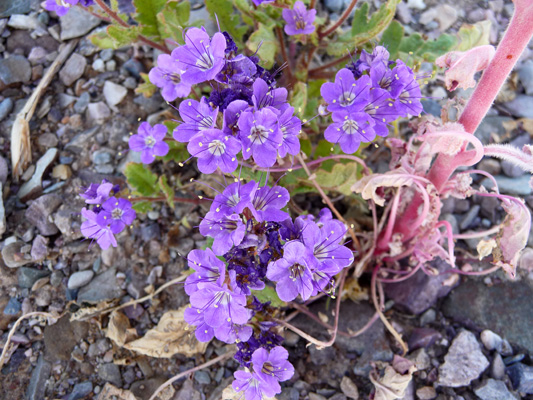
And another Brown-eyed Evening Primrose (Camissonia claiformis).
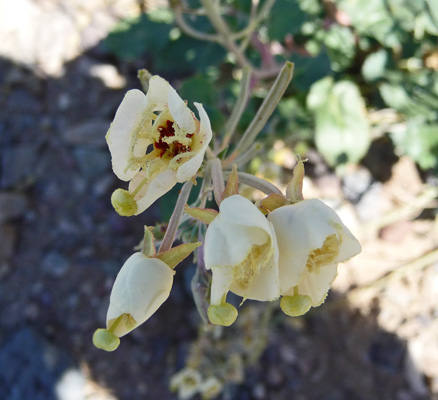
We went back to the trailer for lunch where it was already in the 90’s. It had been in the high 60’s up at Rhyolite and still pleasant up at the pass above Mesquite Flats but Furnace Creek is nearly 200 feet below sea level and it was HOT. With no electrical hookup we couldn’t run the air conditioning (the solar panels do a nice job of providing electricity for all our other needs and they were cranking along putting out 5 amps but that’s not enough to run the AC) so we took a drive instead since the truck has air conditioning.
We’d read that the carpets of Desert Gold were still pretty good south of Badwater (the lowest point in the US at 282 feet below sea level) so we drove south on Badwater Road towards the large alluvial fan at Milepost 25.
On the way I got a nice shot of the snow on the Panamint Mountains to the west.
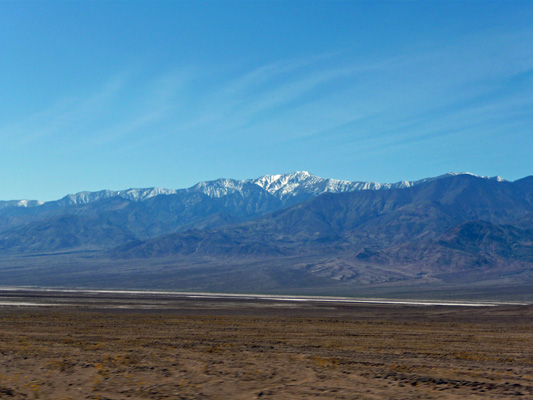
There were lots of Desert Gold in patches here and there along the way and we were not disappointed when we arrived at Milepost 25. Thousands of flowers spread across the alluvial fan. When the valley was at peak they said there had been millions of flowers. This was more than enough for me.
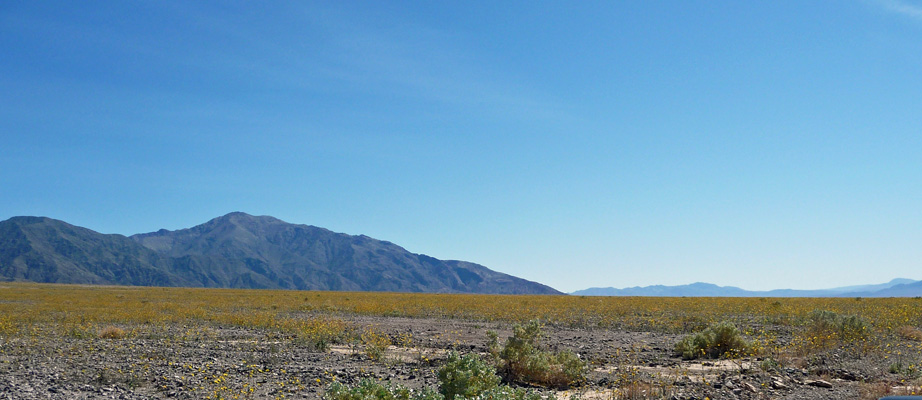
We drove around the fan to the south side and I took a photo of this view looking northwest across the fan.

Looking back northeast you could see the Amargosa Mountains with the flowers in the foreground. The plants weren’t very green but they were still putting out tons of flowers.
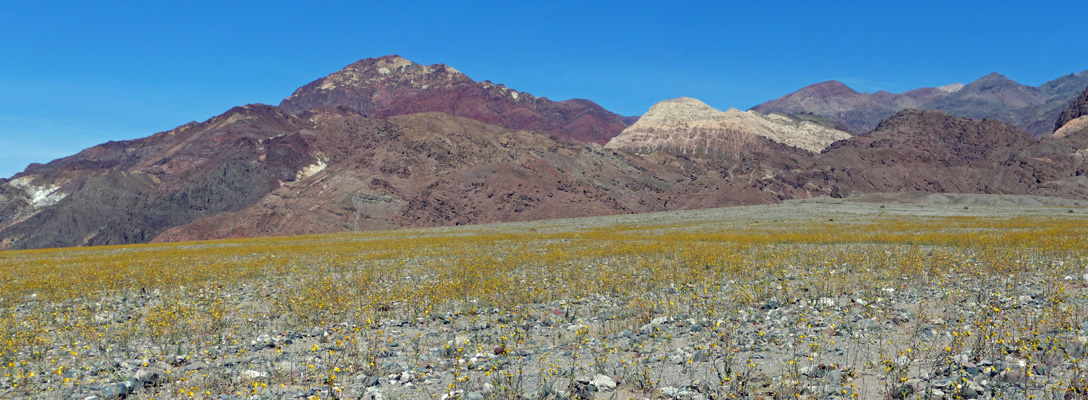
My camera (and my photographic skills) aren’t up to taking those incredible shots where you really can tell what the display looks like, but you get the drift—there were LOTS of flowers.
I thought I’d also give you a nice panorama view of the Amargosa Mountains to the east as we started our way back northward—melting chocolate and vanilla ice cream for sure!

It was all together a very satisfactory day and with the heat we were both perfectly happy to say that 2 nights at Death Valley was enough.
But as a farewell we were treated to a sweet pink sunset which showed up mostly to the northwest. This along with a fellow who did yoga for about 45 minutes out in the big clear sandy area at the end of the campground. If you look carefully you can see him sitting in the lotus position on the ground right of center.
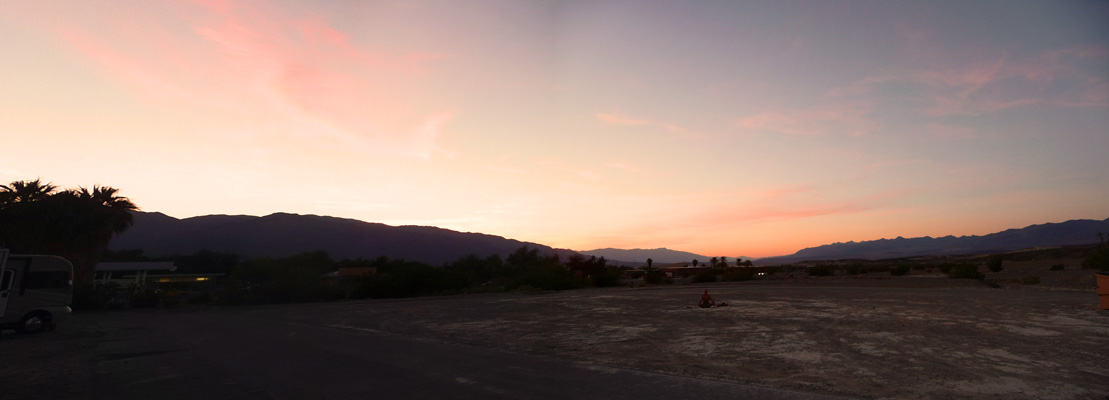
Thursday morning it managed to get down to 60 degrees but it was already in the high 80’s as we left the valley and headed out Highway 190 towards Nevada. Once we got to Death Valley Junction we took State Line Road east towards Pahrump, Nevada. Not far from Ash Meadows National Wildlife Refuge, the Desert Gold went to work again.
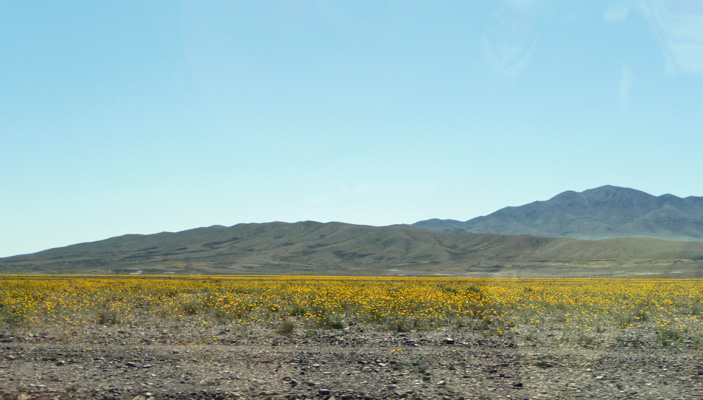
We headed through Pahrump to the east side of town and the Pair-A-Dice Escapee Park. We got their last open spot and signed up for 3 nights (knowing we might opt for a 4th) at $15 a night for a full hookup. We got a nice wide site with a large concrete patio area. This is another Escapee Co-op and while there were other empty spots, those were owned by folks who didn’t place their sites in the rental pool so they weren’t available to people like us. The empty spots made the place feel not so full which was nice. And we were happy to have electricity again since it was warm (though only in the 80’s instead of the 98 that we hit on Wednesday afternoon in Death Valley). We didn’t run the AC but we did have the ceiling fans going most of the time.
We had a few chores to do (including repairing the hinges on the cabinet under the sink) which required a trip or two (or three or four) to Home Depot. The hinge repair ended up to be a big project that included having to take the sink out so there was space to get a drill in to drill some new holes but the good news is that it works perfectly now—for the first time since it swung open as we went down the road and dumped all the canned goods on the floor not long after we got it. As a result of spending so much time fiddling with those hinges, Walter figured out how to fix one of our closet hinges that had gotten bent just a little when we hit one too many speed bumps (or maybe it was too much washboard road) and wouldn’t stay latched. We have a growing cache of tools and screws and both of us know a lot more about how this thing is put together (and how to fix it) than we did before. In any case, we’re all repaired now which is wonderful.
After spending two days tinkering with hinges (crawling around on the floor doing repair yoga as Walter calls it) and doing laundry and grocery shopping we decided we’d stay another night just to have a quiet day. We’d hoped to explore southern Utah next but the weather is just too cold yet at those higher elevations (lows in the 20’s and 30’s for the next 10 days even in Moab) so we’ll be heading towards Arizona instead. Our plan is to go spend some time at Lake Mead and then head south towards Wickenburg and Congress. If the weather holds we’ll go to Prescott and Sedona the week after next. It’s spring break so we know we may run into lots of vacationing folks and we just hope we can find camping spots okay.
